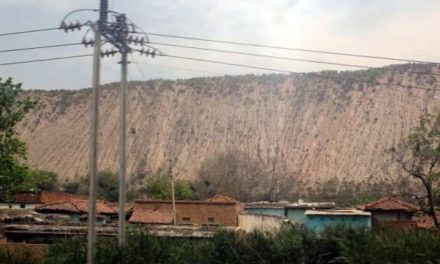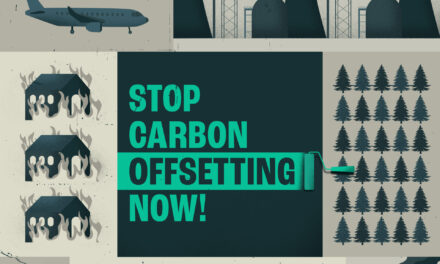REDUCING DEFORESTATION UNDER THE
CLIMATE CONVENTION: FUNDING FORESTS, PLANTATIONS OR FORESTERS?
Simone Lovera*
The tune "The money keeps rolling"
from the musical "Evita" kept playing in my mind as I
witnessed the forest-related wheeling and dealing that took place
during the 13th Conference of the Parties to the Framework Convention
on Climate Change (UNFCCC) in Bali in December. The song describes
how populist governments try to win public support by throwing money
at people, instead of introducing responsible policies that will
alleviate people's poverty in a sustainable manner. Governments'
attitudes to proposals on Reducing Emissions from Deforestation in
Developing Countries (REDD) showed some clear parallels.
The meeting itself was a meager
success, agreeing to a two-year (and very carbon-intensive)
negotiating process. However, in a desperate attempt to keep all
Parties, including the US, on board, the meeting failed to agree upon
a firm basis for future action on mitigating climate change. A
proposal to accept a minimum target for developed countries'
emissions reductions, of 25-40 %, as recommended by the
Intergovernmental Panel on Climate Change (IPCC), was watered down
during the final late-night negotiating sessions. It is now just a
microscopic footnote suggesting governments refer to the IPCC's
reports.
Decisions on forests also failed to
reconfirm existing legally-binding commitments to reduce
deforestation, as laid down in the Convention on Biological Diversity
(CBD). Instead, the final decision merely recommends that governments
"take note" of these commitments.
Nor do the outcomes address the major
outstanding issue of the need for an improved definition of forests.
In the absence of such a new definition, any collection of trees, be
it native or alien and invasive, standing or "temporarily
unstocked", still counts as a forest under the Kyoto Protocol.
This flawed definition is becoming more
problematic than ever, now that the meeting agreed to apply
simplified procedures allowing medium-scale "reforestation and
afforestation projects" (read: tree plantations) to be financed
under the Clean Development Mechanism (CDM).
Governments' ignorance about the
significance of the difference between forests and tree plantations
was illustrated by the fact that all over the Bali conference grounds
participants were invited to offset the emissions of their long
flight by helping to finance the establishment of teak and mahogany
plantations on the island. As if the insecticide-soaked conference
grounds were not artificial enough.
DANCING DOLLARS, DWINDLING RIGHTS
More importantly, the Bali outcomes are
almost totally devoid of any recognition of human rights or social
justice. The rights of Indigenous Peoples, which are enshrined in the
recently adopted UN Declaration on the Rights of Indigenous Peoples,
are still squarely ignored by the UNFCCC process. The social
dimension of forest policy was condensed into one vague reference to
addressing the needs of local and indigenous communities in the
preamble of the decision. The outcomes also fail to recognize the
specific needs and rights of women, in relation to forests and
climate change in general.
Yet, despite the virtual absence of any
guarantee of sound policies to reduce deforestation and promote
forest conservation, the money was very visibly rolling in Bali.
Donor countries demonstrated their
commitment to reducing deforestation by throwing millions of dollars
into the World Bank's newly launched Forest Carbon Partnership
Facility. This was truly remarkable given that the last annual
meeting of the World Bank was dominated by the release of a report by
the World Bank's own Inspection Panel slamming the World Bank's
latest forest scandal: a post-conflict loan to the forestry sector in
the Democratic Republic of Congo. The loan was stated to have
violated practically every internal standard and guideline the World
Bank has, by opening up the Congo Basin to large-scale logging
companies that destroyed massive tracks of pristine rainforests and
trampled the rights and livelihoods of Indigenous communities.
Less than two months later almost a
dozen governments lined up to contribute between 5 and 40 million
dollars each to another major World Bank undertaking on forests. This
demonstrates, perhaps more clearly than anything else, that Northern
countries are more interested in creating a carbon offset market from
which they can buy cheap emission reduction credits, than in
establishing rights-based, effective and equitable forest
conservation mechanisms and policies.
The millions literally danced across
the floor of the Grand Ballroom of the Bali Hyatt on 11 December
2008, when the Forest Carbon Partnership Facility of the World Bank
was launched, with applause and self-congratulation almost drowning
out the shouts of people outside the room, who were calling for the
World Bank to stay out of their forests and respect their land
rights.
A WIN-WIN-WIN FOR NORTHERN DONORS
The World Bank's Forest Carbon
Partnership Facility certainly represents a "win-win-win" option
for donor countries. It presents an easy way of pretending to be
generous and contributing to tropical forest conservation, without
having to bother about responsible funding strategies. If the
Facility turns out to be a disaster, the Bank is an easy black sheep
to blame.
The Facility also encourages
potentially unwilling developing countries to include their forests
in the international carbon market after 2012, providing donor
countries with access to an abundance of cheap credits that help them
avoid painful emission reductions in their own countries.
As an extra bonus, most of the
Facility's funds will undoubtedly flow back into the pockets of an
eager forestry consultancy sector in these same donor countries.
Careful reading of the draft proposal reveals that the majority of
funds will go to the kind of activities the booming forest carbon
consultants sector is very good at: setting up monitoring and
accounting methodologies to estimate carbon stocks and building
countries' capacity to market existing forest conservation projects
as "new and additional" (and thus eligible for carbon credits).
This new forest carbon industry clearly
showed its face at the first Forest Day conference, organized by the
Center for International Forestry Research (CIFOR) in collaboration
with other Collaborative Partnership on Forest partners, on December
8.
Despite CIFOR's own attempts to add
some Indigenous perspectives and gender balance to the meeting, the
day was dominated by hundreds of mainly male and Northern forestry
consultants who flocked together to promote what will undoubtedly
become a very profitable business for them. After all, it is the
forestry consultancy sector that will be called upon to assist
developing countries in their efforts to get 'ready' for the
carbon market.
The World Bank will undoubtedly ask
them to develop monitoring systems and carbon accounting
methodologies, and to design and implement the "pilot projects"
the World Bank has been proposing. Furthermore, the consultancy
overhead in World Bank projects has always been very high. The failed
World Bank-administered Global Environmental Facility Sundarbans
Biodiversity Conservation project in Bangladesh, for example, wasted
no less than 53% of the budget on foreign consultants and an
additional 19% on local consultants and consultancy-related travel.
THE HUMAN GUINEA PIGS WHO
LOSE-LOSE-LOSE
Meanwhile, the forest peoples who will
be the human guinea pigs in this "learning process" will be at
the lose-lose-lose end of the scale. Firstly, they will lose their
forests, due to land grabbing. This has already started now that
(potential) large landholders are realizing they can apply a
"pay-or-I-cut" approach to every hectare of forest land they
succeed in wresting from Indigenous Peoples and landless farmers.
Payment for environmental services
schemes are already having a negative effect on both Indigenous land
rights claims and land reform, and large-scale indirect effects will
not be resolved with vague promises of prior informed consultation in
relation to specific projects. Of course, as UN Permanent Forum on
Indigenous Issues chair Vicky Tauli-Corpuz made clear at the World
Bank launch, prior informed consent regarding initiatives like the
Forest Carbon Partnership Facility itself is entirely different to
prior informed consultation on the ground – especially when there is
no guarantee that the outcomes of that consultation will be taken
seriously. The World Bank's proposed response — a rushed three
months of additional consultations with Indigenous communities —
provides very little confidence in this respect.
Secondly, most Indigenous Peoples and
local communities will not benefit from "pilot projects" to
reduce deforestation, as they do not have deforestation rates to
reduce as most of them have successfully conserved their forests for
centuries. But the Facility and similar REDD (reducing emissions from
deforestation and degradation) proposals are clearly directed towards
compensating destructive logging, soy and oil palm companies and
countries engaged in deforestation. Those same companies and
countries that have, for years, been financed by the World Bank and
other banks to destroy the forests, will now be compensated for a
potential willingness not to do so.
Thirdly, these women and men will lose
because they are in the climate change frontline, with little or no
protection from the coming impacts. Carbon offsets through avoided or
reduced deforestation will compromise the tough but equitable and
rights-based climate regime that is so desperately needed to deal
with the greatest social and moral challenge the world community has
ever dealt with.
BLINDED BY THE EL DORADO OF CARBON
OFFSETS
As expected the formal Bali outcomes on
REDD do not prejudge the all-important question of whether reducing
deforestation will contribute to mitigating climate change, or
whether it will in fact undermine the climate change regime by being
included in the international carbon trade market.
Per definition, carbon offsets do not
reduce emissions (they simply compensate for continued emissions
elsewhere ). Thus including forest-related activities does not mean
that reduced deforestation mechanisms will necessarily lead to
reduced emissions.
Despite this simple fact, and the
deafening rhetoric about the need for urgent action in Bali, a large
number of countries and many conservation groups are still in favor
of financing REDD activities through slow and ineffective carbon
markets. Obviously the El Dorado of billions of dollars going to
their forest conservation activities is too tempting to ignore.
Nevertheless, awareness that efficient carbon offset projects are at
odds with equity, conservation, people's rights and an effective
climate regime does seem to be increasing. And happily, there are
alternatives too. One clear alternative being the Norwegian
government's announcement that they would donate a generous US$545
million per year for the period 2008 – 2012, to help developing
countries conserve forests. This money will come on top of their
emission cuts, not instead of it.
The argument that "there is not
enough official aid money" to conserve forests is false. The
challenge is not so much in the quantity of forest conservation
funding, but in its quality. If dedicated towards constructing the
political will to conserve forests through awareness raising,
education and building the capacity of civil society groups and
Indigenous Peoples' organizations, effective forest conservation
policy does not have to be expensive.
Equitable, rights-based and
cost-effective forest policies include the recognition of Indigenous
and Tribal Peoples' land rights and promoting the hundreds of
small-scale, often women-led forest conservation and restoration
projects that have already succeeded in saving millions of hectares
of forests. Such initiatives also improve forest governance, which is
perhaps the greatest challenge of global forest policy in times of
agrofuel expansion. Because they are cost effective, however, these
projects are far less attractive to the forestry consultancy sector.
One may only hope that governments will
be willing to prioritize the interests of forests and forest peoples,
instead of foresters and their tree plantations, when they proceed on
the road from Bali.
* Simone Lovera is with the Global
Forest Coalition, Paraguay. [email protected]
This article was first published in
Forest Cover, the newsletter of the Global Forest Coalition, which
can be downloaded from www.globalforestcoalition.org.
For more information on the UNFCCC and forests, please visit:
http://unfccc.int and in particular
http://unfccc.int/files/meetings/cop_13/application/pdf/cp_redd.pdf









